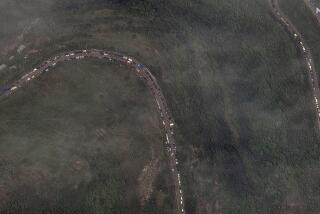Trouble Is Looming for a Centuries-Old Trade
- Share via
DERBENT, Russia — Under the fortress walls, the merchants of this honey-colored stone city at the crossroads of three empires are doing what their ancestors have done for 800 years: laying out hand-woven carpets for sale.
During centuries of conflict under Persian, Turkish and Russian empires, rug salesmen here traditionally have done lucrative business by buying family carpets from refugees on the run from warfare across the Caucasus Mountains and along the shores of the Caspian Sea.
No more.
Something disastrous has started to happen to the region’s hand-made carpet trade in the last two years: Peace keeps breaking out.
“Look at it now,” says woebegone trader Magomed Magomedov, forlornly gesturing around. Just a dozen carpets are pinned up outside the north side of the long defensive wall that Derbent’s onetime Persian masters built in the 6th century. Half a dozen men, all as small and hunched in their flapping black clothes as Magomedov, all with the same mournful expression, are waiting for buyers.
“There’s almost nothing left of our trade,” Magomedov says. “Modern life is killing off the hand-made carpet business.”
The region’s carpet-making legacy from the great carpet cultures of Persia and Turkey was institutionalized under Soviet rule. Factories mass-produced carpets with approximately traditional designs, although village women went on weaving their own--and also continued the practice, frowned on by Communist Party bosses, of giving dowries of carpets at marriage. The huge Derbent market spread across town every weekend.
But the bonanza years for carpet dealers were right after the Soviet Union collapsed. The lands around Russia’s southern border, a tinderbox of Christian and Muslim ethnic groups with long memories for old feuds, went up in flames. In the five years after the 1991 Soviet collapse, there were conflicts between Armenians and Azerbaijanis, Georgians and Abkhazian separatists, and Russians and Chechen separatists.
In the early 1990s, more than a million people fled shattered villages and towns, taking with them only their bedding and carpets. With no money and no homes, the dispossessed were desperate to sell even such treasured symbols of stability and collective history as the carpets to buy food.
But now stability is returning to the region. The wars have stopped or been suspended. The refugees have sold their rugs, and many have found new homes and jobs; so have many of the traders from those days.
The only carpets being made by hand and sold in Derbent are those of women here in the multiethnic republic of Dagestan. But this domestic weaving was never intended as a money-making business and is done more for private, family purposes.
Magomedov’s wife, Asli, is one of the weavers. She has just dismantled the huge loom that stood all winter in front of the family television set. She, her 22-year-old daughter, Zulekha, and her two 20-year-old daughters-in-law, Gyulhara and Vilayad, worked for six months on the huge blue-and-red oblong carpet that now lies on the floor. She’s planning to start weaving again in the fall.
Some of the Magomedovs’ carpets are dowry offerings from the family’s two new daughters-in-law. A betrothed woman’s family still must provide at least one big carpet, a flat-weave rug, a runner and half a dozen cushions. Her mother and sisters can help her weave them, but the designs should be her own.
Traditional Caucasus carpets differ in design from region to region, village to village. They include both Persian motifs--intricate floral patterns--and wilder, brighter, coarser Turkish-influenced designs, with jagged flame-like shapes.
But some of the modern carpets, cushions, runners and wall hangings that decorate houses here have designs that draw as much from Western pop culture as Eastern tradition. Snoopys and Snow Whites crop up, along with compositions of pink-faced children and baskets of puppies.
Asli, who was laid off from her job at the near-bankrupt Soviet-era carpet factory a few years ago, loves weaving. She collects templates--patterns of tiny crosses on squared paper--just as some Western women collect knitting patterns. She studies them in her free moments, contemplating her next adventure in quiet creativity.
But, she complains, her work doesn’t bring in much money. The most she can expect her husband to get for this winter’s rug, measuring 6 feet by 10 feet, is $600.
“Four of us worked on it for six months,” she laments. “And that means we only earned $25 a month each. A pittance.”
The worst blow of all to the trade is the flippancy with which post-Soviet Dagestanis have begun to treat their traditions.
Although it’s still considered crucial to transfer carpets from family to family at marriage, her husband says, it’s no longer a matter of pride to give the most beautiful and costly weaving possible.
And Russia’s opening of its borders means that there’s new competition in the rug business from an unexpected quarter: the West.
Inside Derbent’s city walls, just yards from the deserted handmade carpet market, an altogether more flourishing trade is now going on in cheap Belgian or Belarussian carpets made with synthetic fibers.
These crackling, brownish rugs, with large swirly patterns, stand rolled up against walls, or are displayed on clotheslines or cars. Surly traders with none of the traditional carpet salesman’s patter say they buy them from four or five big warehouses in Moscow and bring them down to the south for sale. They cost only one-fifth as much as hand-woven rugs.
“So what do people do before a wedding?” Magomedov asks with a mixture of indignation and resignation. “They know they’ve got to give carpets. But they couldn’t care less what kind. So they get the cheapest possible Belgian thing and palm it off on their new family. For people like that, respect for tradition is becoming no more than a formality.”
More to Read
Sign up for Essential California
The most important California stories and recommendations in your inbox every morning.
You may occasionally receive promotional content from the Los Angeles Times.













